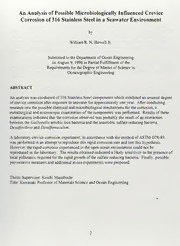
An analysis of possible microbiologically influenced crevice corrosion of 316 stainless steel in a seawater environment PDF
Preview An analysis of possible microbiologically influenced crevice corrosion of 316 stainless steel in a seawater environment
An Analysis of Possible Microbiologically Influenced Crevice Corrosion of 316 Stainless Steel in a Seawater Environment by William R. N. ftowell Jr. B.S. Biomedical Engineering Tulane University (1984) SUBMITTED TO THE DEPARTMENT OF OCEAN ENGINEERING IN PARTIAL FULFILLMENT OF THE REQUIREMENTS FOR THE DEGREE OF MASTER OF SCIENCE IN OCEANOGRAPH1C ENGINEERING at the MASSACHUSETTS INSTITUTE OF TECHNOLOGY and the WOODS HOLE OCEANOGRAPKC INSTITUTION SEPTEMBER 1996 © Massachusetts Institute ofTechnology 1996. All Rights Reserved //// I a. An Analysis of Possible Microbiologically Influenced Crevice Corrosion of316 Stainless Steel in a Seawater Environment by William R. N. Howell Jr. Submitted to the Department ofOcean Engineering on August 9, 1996 in Partial Fulfillment ofthe Requirements for the Degree ofMaster ofScience in Oceanographic Engineering ABSTRACT An analysis was conducted of316 Stainless Steel components which exhibited an unusual degree ofcrevice corrosion after exposure to seawater for approximately one year. After conducting research into the possible chemical and microbiological mechanisms for the corrosion, a metallurgical and microscopic examination ofthe components was performed. Results ofthese examinations indicated that the corrosion observed was probably the result ofan interaction between the Gallionella aerobic iron bacteria and the anaerobic sulfate reducing bacteria Desulfovibrio and Desulfomaculum. A laboratory crevice corrosion experiment, in accordance with the method ofASTM G78-89. was performed in an attempt to reproduce this rapid corrosion rate and test this hypothesis. However, the rapid corrosion experienced in the open ocean environment could not be reproduced in the laboratory. The results obtained indicated a likely sensitivity to the presence of local pollutants, required for the rapid growth ofthe sulfate reducing bacteria. Finally, possible preventative measures and additional at-sea experiments were proposed. Thesis Supervisor: Koichi Masubuchi Title: Kawasaki Professor ofMaterials Science and Ocean Engineering Acknowledgments In response to a compliment on his discoveries, Sir Isaac Newton said: "IfI have seen farther than other men. it is because I stood on the shoulders ofgiants." In completing this thesis and my Masters. I too have stood on the shoulders ofothers. This thesis could not have been completed without the help and guidance ofProfessor Koichi Masubuchi ofMIT and Dr. Albert "Sandy" Williams ofWHOI. Gentlemen, please accept my profoundest thanks; I shall try to put what you have each taught me to good use in my future endeavors. I would like to thank my fellow graduate student Dave Walworth for all his assistance in teaching how to use the video and laser microscopes in the Welding Laboratory at MIT. Thanks also to LTJG Tom Singleton, for making me aware that this corrosion problem existed and could well serve as the basis ofa thesis. Lastly, my greatest thanks go to my family, my wife Elaine and daughter Liana. For helping me with everything from photographing specimens to purchasing 120-grit paper, you've both been there for me whenever I needed you. Your love and support have been what kept me going and made possible whatever I have accomplished.
